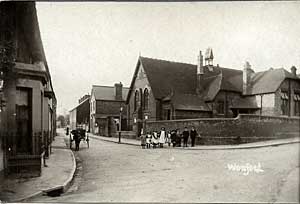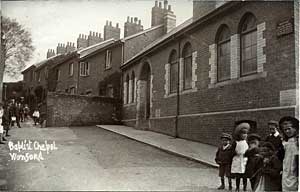
Wonford
Page updated 6 December 2008
The land surrounding Exeter had been part of the Celtic kings estates from before the Romans. Hoskins refers to Exeter sitting as the peach stone surrounded by the flesh of Wonford. In the 7th century, these lands continued to be a large royal estate of the Saxon kings.
This royal estate was named Wonford after a stream (now called Mincinglake) that rose on the southern slopes of Stoke Hill and flowed through Northbrook Park. In 937, the name was wynford meaning ford on a fair stream. Avon is a related word. These lands were gradually reduced in size, until the only remaining hunting ground remaining at the Norman invasion was Duryard, north of the city.
Although St Michael's Church in Heavitree is Victorian, it stands on the place of one of the oldest churches outside Exeter. The Wessex King Cenwealh, established a chapel at this position near the sacred head tree in Wonford in about 660. The area became known as Heavitree, and Wonford shrank as Heavitree grew.
Bishop Brantyngham's Register of the See of Exeter mentions Wonford and St Eligious or St Loye:
"At Clyst, on the first day of April, 1387, the Lord Bishop granted a license to Henry Tirell and Joan his wife, to enable them to have Divine Service performed by a fit Priest, in their presence, or of any one else, in the Chapel of St. Eligiuos, situate within the mansion of the same, at Wonford in the parish of Heavitree...."
In 1802 Mr Robert Donnall of St Thomas was appointed the inspector of the hundred of Wonford. Much of the area to the east of Exeter that was referred to as South Wonford and beyond was still agricultural with frequent reports in the Flying Post of hay making, the harvest and prize oxen. By 1830, Wonford was referred as 'in the parish of Heavitree'. In 1849 the parish of Ashton was transferred from Teignbridge to the Wonford Division. There was a firing range in Wonford that was used by the Devonshire's through the 19th-century for practice firing.
The first report to the 'Divisional Petty Sessions' Wonford at the court at the Castle was in 1862, when St Thomas Union seems to have subdivided their area for judicial purposes. Cases from across the east of the city from Trews Weir to Heavitree, Sowton, Pinhoe, Netherexe and even St Thomas were heard in the Wonford Division. From the 1870's there was a Wonford 'Highway Board' that also met at the Castle covering the same area. Politically, Tiverton and Wonford were also joined, as demonstrated by the Tiverton and Wonford Conservative Association.
It is difficult to define the modern Wonford as it is not a political area, but most Exonians know where you mean, when you say 'Wonford'. Wonford Street could be thought to be the heart of the area while Wonford Road winds from Magdalen Road to the junction with Barrack Road. Exeter's main hospital, the Royal Devon and Exeter, is situated in Wonford.
 Wonford Village before the Great
War.
Wonford Village before the Great
War.
 Wonford Baptist Chapel.
Wonford Baptist Chapel.
│ Top of Page │